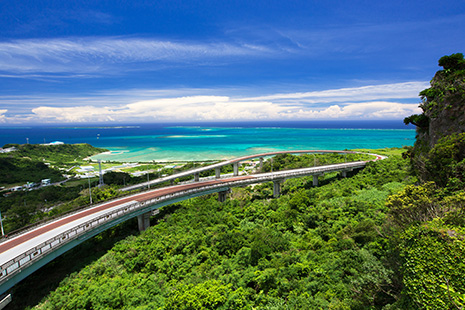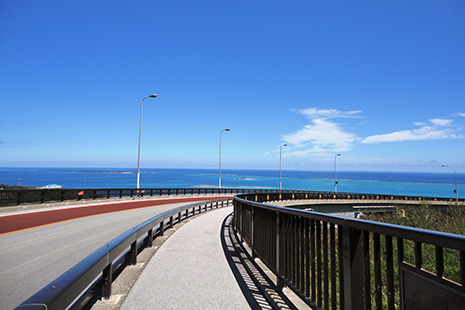March 2024
- English
- 日本語
The Beautiful Nirai Bridge and Kanai Bridge, Enhancing Okinawa's Landscape
-

On clear days, visitors can enjoy the amazing scenery, which includes views of the Nirai Bridge and Kanai Bridge. -

Crossing the bridge offers a chance to view the beautiful cobalt blue sea.
-

The Nirai Bridge is located on the mountain side, while the Kanai Bridge is situated on the sea side. -

A stunning view of the sea unfolds beyond the tunnel.

Situated along Prefectural Route 86 in Nanjo City in the southern part of Okinawa's main island, the Nirai Bridge and Kanai Bridge offer breathtaking views of the Pacific Ocean, attracting numerous visitors from both within and beyond Okinawa Prefecture.
Nanjo City, located approximately 12 kilometers southeast of Naha City on the eastern coast in the southern part of Okinawa's main island, is home to the Nirai Bridge and Kanai Bridge. These bridges connect Prefectural Route 86 (Haebaru Chinen Line) to National Route 331, forming a popular driving route from the city to the cape.
In ancient Okinawan culture, 'Nirai-Kanai' represents an ideal paradise believed to lie beyond the sea or beneath the ocean. According to local myths, gods from Nirai-Kanai visit the human world, bringing prosperity and abundance.
The explanation of Nirai Bridge and Kanai Bridge by the Okinawa southern civil engineering office is as follows.
"Despite appearing as a single long bridge, it is actually two bridges with different structural types connected. The Nirai Bridge curves downward from the north, tracing the natural slope from the mountains to the sea, whereas the Kanai Bridge stretches outward from a switchback point adjacent to a monument, curving until it reaches a destination known as Yoshitomi."

According to Okinawa's Road Administration Division, "The construction plan for the bridges incorporated significant curves to accommodate the challenging terrain, with an elevation difference of 80 meters, ensuring proper vertical alignment." This design transformed the bridges into scenic viewpoints, offering wonderful panoramic views of Cape Chinen. Additionally, the completion of Prefectural Route 86 significantly enhanced transportation accessibility from the Chinen area to Naha. "The bridges are also featured in the Shouhashi Half Marathon, an annual event in Nanjo City that attracts numerous participants."

The combined length of the two bridges is approximately 660 meters, and visitors have the option to explore the area on foot. The Tourism and Commerce Section of the Planning Department at Nanjo City Hall recommends the bridges as a must-visit destination. "The bridges offer expansive views of the sea and sky, presenting breathtaking scenery. On clear days, you can marvel at the beauty of the deep blue sea and sky, resembling a picturesque painting. Descending towards the sea, you're greeted with the most magnificent views from your car window, especially as you emerge from the tunnel, revealing the stunning expanse of the sea before you. The view from the bridge, arching dramatically toward the ocean, is truly spectacular. These panoramic views truly embody the concept of 'paradise beyond the sea.' For the optimal ocean views, consider visiting around noon. Visitors can gaze upon Cape Chinen and Kudaka Island*, also known as the 'Island of the Gods' in Okinawa, visible in the distance amid the cobalt blue sea. Access to Kudaka Island is available through high-speed boat or ferry services."

Why not take some time to soak in the view from the bridge and reflect on the spirit of Okinawa?
* In Okinawan myths and rituals, Amamikiyo, revered as the deity from which the Ryukyuan civilization is believed to have originated, is thought to have descended from Nirai-Kanai, the realm of the gods, to Kudaka Island.

